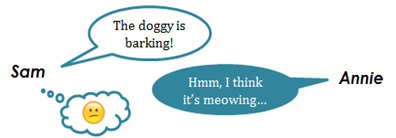
In the English language, speakers often alternate between sentences like (1) and (2) when producing complex sentences¹.
1. [Tom thinks] that (the cake shop is closed today).
[Main clause] + complementiser + (subordinate clause).
2. [Tom thinks] (the cake shop is closed today).
[Main clause] + (subordinate clause).
The key difference here is the addition of “that”, known in linguistic terms as a complementiser. How “that” is interpreted though remains relatively unclear: does its inclusion change the focus of a sentence?
Some research appears to say yes²³! Researchers looking at spontaneous speech in both children and adults have argued that for complex sentences like (1), attention is paid to the overall statement – Tom’s thought about the cake shop. However with (2), focus is shifted to the event itself – the shop’s closure. The first part of the sentence tells us about the speaker’s judgement of or level of confidence in the truth of the second part²³. In linguistic terms: The main clause in (2) serves as an epistemic marker or ‘attention getter’ rather than a fully-functioning main clause². So in actual fact, it is the subordinate content that is key to the ongoing conversation³. At present, there is not enough research to say this for sure. But why is all of this important for understanding children’s language development? LuCiD researchers Anna Theakston, Silke Brandt and I ran a study to find out.
The sentence presented in (2) is a great example of the complex sentences children first produce with think. In using these mental verbs, children are not actually trying to communicate their inner thoughts, but how certain they are about the information that follows⁴ – so much so that the main clause (“Tom thinks”) could be replaced with maybe and the meaning of the sentence would stay the same⁵! It is perhaps unsurprising then that children’s understanding of these more complex sentence types appears to be linked to their understanding of false belief, which is achieved in children around age 5⁶.
False belief understanding involves the appreciation that i) people can have different beliefs to you and ii) these beliefs don’t necessarily reflect reality⁷.

Researchers have not yet firmly established which occurs first in a child’s development – understanding of complex syntax or of false belief – though it is generally accepted that a link between them exists⁶.
With the above in mind: We wanted to see how that-complementisers and false beliefs presented in story scenarios affect which part of a sentence children focus on. In addition, we also wanted to investigate the influence of children’s false belief understanding more generally. By assessing children’s responses in our complement clause production task, we were able to see which pieces of information children felt were most important for answering our story-related questions. Each story included crucial sentences which either i) included or deleted the that-complementiser and ii) revealed the story character’s belief to be true or false, or offered neutral unrelated information (e.g. Oh look, there’s a blue star). Here’s a sample story:

So, did children judge that it was the belief (by using the main plus subordinate clause “he thinks it’s closed today”) or the state of affairs (by using the subordinate alone “it’s closed today”) that resulted in the story character not being able to engage in some activity?
On the whole, each group (4-year-olds, 5-year-olds and an adult control group) answered the experimenter’s question with main and subordinate clauses most frequently when the story included a false belief (e.g. “oh look, it actually isn’t closed today!”). This suggests participants felt it was important to use the whole sentence including a mention of the character’s thought or belief – which actually turned out to be false – to explain why they couldn’t engage in their activity. Though the children’s general false belief understanding scores did not predict how they answered story questions, our results did show that even 4-year-olds are starting to understand the difference between true and false beliefs when presented in story contexts, and are also beginning to use the appropriate language to demonstrate this. That said, they did not use full complex sentences as often as the older children (5-year-olds) or the adults group.
What’s interesting is that some children attempted to show their understanding in other ways, using sentences like “because it’s not closed” or “because it’s open”. For starters, this doesn’t make too much sense in terms of answering our question “why doesn’t Tom go to the cake shop?”! But it does show how these children have recognised that there is something different about these false belief stories; it might just be that they are not yet able to communicate this using more complex language like “he thinks” to refer to other’s thoughts, beliefs and attitudes.
We also found that the inclusion or deletion of the that-complementiser in the crucial sentence had no effect on participant’s responses, which is important in terms of adding to the literature in this area by presenting results from an experimental study.
In the German language, when complementisers are deleted the word order of the sentence is changed, so its absence is more somewhat more noticeable. We therefore thought it’d be interesting to run this experiment with German-speaking children and adults to see whether differences exist in how they interpret and produce these types of complex sentences. Keep a look out for the results of this study!
References
¹Thompson, S. A., & Mulac, A. (1991). The discourse conditions for the use of the complementizer that in conversational English. Journal of pragmatics, 15(3), 237-251.
²Diessel, H., & Tomasello, M. (2001). The acquisition of finite complement clauses in English: A corpus-based analysis. Cognitive Linguistics, 12(2), 97–141.
³Thompson, S. A. (2002). “Object complements” and conversation towards a realistic account. Studies in Language. International Journal sponsored by the Foundation “Foundations of Language”, 26(1), 125-163.
⁴Shatz, M., Wellman, H. M., & Silber, S. (1983). The acquisition of mental verbs: A systematic investigation of the first reference to mental state. Cognition, 14(3), 301-321.
⁵Limber, J. (1973). The genesis of complex sentences. Cognitive development and the acquisition of language, 169-185.
⁶Milligan, K., Astington, J. W., & Dack, L. A. (2007). Language and theory of mind: meta‐analysis of the relation between language ability and false‐belief understanding. Child development, 78(2), 622-646.
⁷Diessel, H. (2004). The acquisition of complex sentences. Cambridge, UK: Cambridge University.

